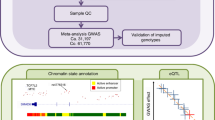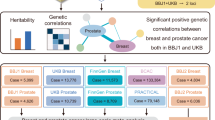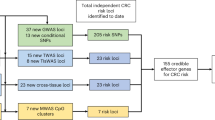Abstract
Esophageal adenocarcinoma is a cancer with rising incidence and poor survival. Most such cancers arise in a specialized intestinal metaplastic epithelium, which is diagnostic of Barrett's esophagus. In a genome-wide association study, we compared esophageal adenocarcinoma cases (n = 2,390) and individuals with precancerous Barrett's esophagus (n = 3,175) with 10,120 controls in 2 phases. For the combined case group, we identified three new associations. The first is at 19p13 (rs10419226: P = 3.6 × 10−10) in CRTC1 (encoding CREB-regulated transcription coactivator), whose aberrant activation has been associated with oncogenic activity. A second is at 9q22 (rs11789015: P = 1.0 × 10−9) in BARX1, which encodes a transcription factor important in esophageal specification. A third is at 3p14 (rs2687201: P = 5.5 × 10−9) near the transcription factor FOXP1, which regulates esophageal development. We also refine a previously reported association with Barrett's esophagus near the putative tumor suppressor gene FOXF1 at 16q24 and extend our findings to now include esophageal adenocarcinoma.
This is a preview of subscription content, access via your institution
Access options
Subscribe to this journal
Receive 12 print issues and online access
$209.00 per year
only $17.42 per issue
Buy this article
- Purchase on Springer Link
- Instant access to full article PDF
Prices may be subject to local taxes which are calculated during checkout


Similar content being viewed by others
References
Jochem, V.J., Fuerst, P.A. & Fromkes, J.J. Familial Barrett's esophagus associated with adenocarcinoma. Gastroenterology 102, 1400–1402 (1992).
Crabb, D.W. et al. Familial gastroesophageal reflux and development of Barrett's esophagus. Ann. Intern. Med. 103, 52–54 (1985).
Poynton, A.R., Walsh, T.N., O'Sullivan, G. & Hennessy, T.P. Carcinoma arising in familial Barrett's esophagus. Am. J. Gastroenterol. 91, 1855–1856 (1996).
Romero, Y. et al. Familial aggregation of gastroesophageal reflux in patients with Barrett's esophagus and esophageal adenocarcinoma. Gastroenterology 113, 1449–1456 (1997).
Melzer, E., Shtoyerman, R., Appelman, Z. & Kashtan, H. Familial Barrett's adenocarcinoma. Am. J. Gastroenterol. 101, 677 (2006).
Groves, C., Jankowski, J., Barker, F. & Holdstock, G. A family history of Barrett's oesophagus: another risk factor? Scand. J. Gastroenterol. 40, 1127–1128 (2005).
Trudgill, N.J., Kapur, K.C. & Riley, S.A. Familial clustering of reflux symptoms. Am. J. Gastroenterol. 94, 1172–1178 (1999).
Chak, A. et al. Identification of Barrett's esophagus in relatives by endoscopic screening. Am. J. Gastroenterol. 99, 2107–2114 (2004).
Fitzgerald, R.C. Complex diseases in gastroenterology and hepatology: GERD, Barrett's, and esophageal adenocarcinoma. Clin. Gastroenterol. Hepatol. 3, 529–537 (2005).
Amos, C.I. et al. Genome-wide association study identifies novel loci predisposing to cutaneous melanoma. Hum. Mol. Genet. 20, 5012–5023 (2011).
Gogarten, S.M. et al. GWASTools: an R/Bioconductor package for quality control and analysis of genome-wide association studies. Bioinformatics 28, 3329–3331 (2012).
Strange, A. et al. A genome-wide association study identifies new psoriasis susceptibility loci and an interaction between HLA-C and ERAP1. Nat. Genet. 42, 985–990 (2010).
Willer, C.J., Li, Y. & Abecasis, G.R. METAL: fast and efficient meta-analysis of genomewide association scans. Bioinformatics 26, 2190–2191 (2010).
Su, Z. et al. Common variants at the MHC locus and at chromosome 16q24.1 predispose to Barrett's esophagus. Nat. Genet. 44, 1131–1136 (2012).
Ek, W.E. et al. Germline genetic contributions to risk for esophageal adenocarcinoma, Barrett's esophagus and gastroesophageal reflux. J. Natl. Cancer Inst. (in the press).
Gu, Y. et al. Altered LKB1/CREB-regulated transcription co-activator (CRTC) signaling axis promotes esophageal cancer cell migration and invasion. Oncogene 31, 469–479 (2012).
Montgomery, S.B. et al. Transcriptome genetics using second generation sequencing in a Caucasian population. Nature 464, 773–777 (2010).
Cheung, L.W.T. et al. High frequency of PIK3R1 and PIK3R2 mutations in endometrial cancer elucidates a novel mechanism for regulation of PTEN protein stability. Cancer Discov. 1, 170–185 (2011).
Cortés, I. et al. p85β phosphoinositide 3-kinase subunit regulates tumor progression. Proc. Natl. Acad. Sci. USA 109, 11318–11323 (2012).
Venturi, S. & Venturi, M. Iodine in evolution of salivary glands and in oral health. Nutr. Health 20, 119–134 (2009).
Jankowski, J., Hopwood, D. & Wormsley, K.G. Expression of epidermal growth factor, transforming growth factor α and their receptor in gastro-oesophageal diseases. Dig. Dis. 11, 1–11 (1993).
Menke, V. et al. Functional single-nucleotide polymorphism of epidermal growth factor is associated with the development of Barrett's esophagus and esophageal adenocarcinoma. J. Hum. Genet. 57, 26–32 (2012).
Lanuti, M. et al. A functional epidermal growth factor (EGF) polymorphism, EGF serum levels, and esophageal adenocarcinoma risk and outcome. Clin. Cancer Res. 14, 3216–3222 (2008).
ENCODE Project Consortium. An integrated encyclopedia of DNA elements in the human genome. Nature 489, 57–74 (2012).
Elks, C.E. et al. Thirty new loci for age at menarche identified by a meta-analysis of genome-wide association studies. Nat. Genet. 42, 1077–1085 (2010).
Altarejos, J.Y. et al. The Creb1 coactivator Crtc1 is required for energy balance and fertility. Nat. Med. 14, 1112–1117 (2008).
Koon, H.B., Ippolito, G.C., Banham, A.H. & Tucker, P.W. FOXP1: a potential therapeutic target in cancer. Expert Opin. Ther. Targets 11, 955–965 (2007).
Shu, W. et al. Foxp2 and Foxp1 cooperatively regulate lung and esophagus development. Development 134, 1991–2000 (2007).
Boyle, A.P. et al. Annotation of functional variation in personal genomes using RegulomeDB. Genome Res. 22, 1790–1797 (2012).
Woo, J., Miletich, I., Kim, B.-M., Sharpe, P.T. & Shivdasani, R.A. Barx1-mediated inhibition of Wnt signaling in the mouse thoracic foregut controls tracheo-esophageal septation and epithelial differentiation. PLoS ONE 6, e22493 (2011).
Dura, P. et al. Barrett associated MHC and FOXF1 variants also increase esophageal carcinoma risk. Int. J. Cancer 133, 1751–1755 (2013).
Laurie, C.C. et al. Quality control and quality assurance in genotypic data for genome-wide association studies. Genet. Epidemiol. 34, 591–602 (2010).
Peiffer, D.A. et al. High-resolution genomic profiling of chromosomal aberrations using Infinium whole-genome genotyping. Genome Res. 16, 1136–1148 (2006).
Price, A.L. et al. Principal components analysis corrects for stratification in genome-wide association studies. Nat. Genet. 38, 904–909 (2006).
Novembre, J. et al. Genes mirror geography within Europe. Nature 456, 98–101 (2008).
R Development Core Team. R: A Language and Environment for Statistical Computing (R Foundation for Statistical Computing, Vienna, 2006).
Zheng, X. et al. A high-performance computing toolset for relatedness and principal component analysis of SNP data. Bioinformatics 28, 3326–3328 (2012).
Li, Y., Willer, C.J., Ding, J., Scheet, P. & Abecasis, G.R. MaCH: using sequence and genotype data to estimate haplotypes and unobserved genotypes. Genet. Epidemiol. 34, 816–834 (2010).
Purcell, S. et al. PLINK: a tool set for whole-genome association and population-based linkage analyses. Am. J. Hum. Genet. 81, 559–575 (2007).
Acknowledgements
We thank P. Christopherson, P. Hansen, L. Nolan and T. Watson for their efforts in project management and the organization of biospecimens and data, and we thank Cathy Laurie, Cecelia Laurie and B. Weir for helpful suggestions regarding analyses.
This work was primarily funded by a US National Institutes of Health (NIH) grant (R01CA136725) to T.L.V. and D.C.W. T.L.V. is also supported by grant K05CA124911. D.C.W. is supported by a Future Fellowship (FT0990987) from the Australian Research Council. S.M. is supported by an Australian National Health and Medical Research Council (NHMRC) Career Development Award. N.K.H. is supported by Research Fellowships from the NHMRC of Australia. Y.R. is supported in part by a grant from the US NIH (NIDDK 02956), the Robert Wood Johnson Foundation Harold Amos Medical Faculty Development Program and the Fraternal Order of the Eagles.
The Swedish Esophageal Cancer Study was funded by grants (R01 CA57947-03) from the National Cancer Institute and the Swedish Cancer Society (4559-B01-01XAA and 4758-B02-01XAB). The Kaiser-Permanente Study was supported by grants from the US NIH (R01DK63616 and R01CA59636) and from the California Tobacco-Related Research Program (3RT-0122 and 10RT-0251). The UK Barrett's oesophagus gene study was funded by a Medical Research Council Programme grant, and the UK SOCS study was funded by Cancer Research UK as well as by the Cambridge National Institute for Health Research Biomedical Research Centre and the Cambridge Experimental Cancer Medicine Centre. The SEARCH grant was funded by Cancer Research UK grants C490/A10119 and C490/A10124.
Genotyping of MD Anderson controls (C. Amos, PI) was performed through the University of Texas MD Anderson Cancer Center (UTMDACC) and the Johns Hopkins University Center for Inherited Disease Research (CIDR), supported in part by US NIH grants R01CA100264, P30CA016672 and R01CA133996 and the UTMDACC NIH SPORE in Melanoma 2P50CA093459, as well as by the Marit Peterson Fund for Melanoma Research. CIDR is supported by contract HHSN268200782096C from the US NIH.
This study made use of data generated by the Wellcome Trust Case Control Consortium. Funding for the project was provided by the Wellcome Trust under award 076113. A full list of the investigators who contributed to the generation of the data is available from the website (see URLs).
The Romero Registry is supported in part by the American Digestive Health Foundation Endoscopic Research Award, the American College of Gastroenterology Junior Faculty Development Award, the Glaxo Wellcome, Inc., Institute for Digestive Health Clinical Research Award and the Miles and Shirley Fiterman Center for Digestive Diseases at the Mayo Clinic (Rochester, Minnesota). The Romero Registry also receives charitable gifts from five industry partners (Affymetrix, AstraZeneca, Santarus, Takeda and Wyeth). The US Multicenter Study was funded by grants U01CA57949, U01CA57983 and U01CA57923 from the US NIH.
Members of the Romero Registry: Sami R. Achem (Mayo Clinic, Jacksonville, Florida, USA), Yvonne Romero (Mayo Clinic, Rochester, Minnesota, USA), David A. Ahlquist (Mayo Clinic, Rochester, Minnesota, USA), Steven R. Alberts (Mayo Clinic, Rochester, Minnesota, USA), Jeffrey A. Alexander (Mayo Clinic, Rochester, Minnesota, USA), Mark S. Allen (Mayo Clinic, Rochester, Minnesota, USA), Amindra S. Arora (Mayo Clinic, Rochester, Minnesota, USA), Jonathan B. Ashman (Mayo Clinic, Phoenix, Arizona, USA), Pamela J. Atherton (Mayo Clinic, Rochester, Minnesota, USA), Lisa A. Boardman (Mayo Clinic, Rochester, Minnesota, USA), Ernest P. Bouras (Mayo Clinic, Jacksonville, Florida, USA), Vicki A. Bryhn (Mayo Clinic, Rochester, Minnesota, USA), Patrick A. Burch (Mayo Clinic, Rochester, Minnesota, USA), George E. Burdick (Mayo Clinic, Rochester, Minnesota, USA), Navtej S. Buttar (Mayo Clinic, Rochester, Minnesota, USA), John K. Camoriano (Mayo Clinic, Phoenix, Arizona, USA), John R. Cangemi (Mayo Clinic, Jacksonville, Florida, USA), Stephen D. Cassivi (Mayo Clinic, Rochester, Minnesota, USA), Frances K. Cayer (Mayo Clinic, Jacksonville, Florida, USA), Amy C. Clayton (Mayo Clinic, Rochester, Minnesota, USA), Michael D. Crowell (Mayo Clinic, Phoenix, Arizona, USA), Julie M. Cunningham (Mayo Clinic, Rochester, Minnesota, USA), Mariza de Andrade (Mayo Clinic, Rochester, Minnesota, USA), Piet de Groen (Mayo Clinic, Rochester, Minnesota, USA), Giovani De Petris (Mayo Clinic, Phoenix, Arizona, USA), Claude Deschamps (Mayo Clinic, Rochester, Minnesota, USA), Kenneth R. DeVault (Mayo Clinic, Jacksonville, Florida, USA), Robert B. Diasio (Mayo Clinic, Rochester, Minnesota, USA), John K. DiBaise (Mayo Clinic, Phoenix, Arizona, USA), Eric S. Edell (Mayo Clinic, Rochester, Minnesota, USA), Sharon Elcombe (Mayo Clinic, Rochester, Minnesota, USA), Charles Erlichman (Mayo Clinic, Rochester, Minnesota, USA), Douglas O. Faigel (Mayo Clinic, Phoenix, Arizona, USA), Tom R. Fitch (Mayo Clinic, Phoenix, Arizona, USA), David E. Fleischer (Mayo Clinic, Phoenix, Arizona, USA), Jean C. Fox (Mayo Clinic, Rochester, Minnesota, USA), Amy E. Foxx-Orenstein (Mayo Clinic, Rochester, Minnesota, USA), Dawn Francis (Mayo Clinic, Rochester, Minnesota, USA), Mary B. Fredericksen (Mayo Clinic, Rochester, Minnesota, USA), Evanthia Galanis (Mayo Clinic, Rochester, Minnesota, USA), Debra M. Geno (Mayo Clinic, Rochester, Minnesota, USA), Axel Grothey (Mayo Clinic, Rochester, Minnesota, USA), Michael G. Haddock (Mayo Clinic, Rochester, Minnesota, USA), Kevin C. Halling (Mayo Clinic, Rochester, Minnesota, USA), Denise M. Harnois (Mayo Clinic, Jacksonville, Florida, USA), Tracy W. Hilton (Mayo Clinic, Jacksonville, Florida, USA), Timothy Hobday (Mayo Clinic, Rochester, Minnesota, USA), Lesley A. Houghton (Mayo Clinic, Jacksonville, Florida, USA), Prasad A. Iyer (Mayo Clinic, Rochester, Minnesota, USA), Dawn E. Jaroszewski (Mayo Clinic, Phoenix, Arizona, USA), Aminah Jatoi (Mayo Clinic, Rochester, Minnesota, USA), Robert B. Jenkins (Mayo Clinic, Rochester, Minnesota, USA), Elizabeth A. Johnson (Mayo Clinic, Jacksonville, Florida, USA), Rajni Katipamula (Mayo Clinic, Rochester, Minnesota, USA), David A. Katzka (Mayo Clinic, Rochester, Minnesota, USA), Sharon F. Kaufman (Mayo Clinic, Rochester, Minnesota, USA), Andrew P. Keaveny (Mayo Clinic, Jacksonville, Florida, USA), Daniel A. Keller (Mayo Clinic, Rochester, Minnesota, USA), George P. Kim (Mayo Clinic, Jacksonville, Florida, USA), Benjamin R. Kipp (Mayo Clinic, Rochester, Minnesota, USA), Dora M. Lam-Himlin (Mayo Clinic, Rochester, Minnesota, USA), Stephen M. Lange (Mayo Clinic, Jacksonville, Florida, USA), Louis Lanza (Mayo Clinic, Phoenix, Arizona, USA), Shauna N. Legrand (Mayo Clinic, Jacksonville, Florida, USA), Paul J. Limburg (Mayo Clinic, Rochester, Minnesota, USA), Wilma L. Lingle (Mayo Clinic, Rochester, Minnesota, USA), Wanguo Liu (Mayo Clinic, Rochester, Minnesota, USA), G. Richard Locke III (Mayo Clinic, Rochester, Minnesota, USA), David S. Loeb (Mayo Clinic, Jacksonville, Florida, USA), Lori S. Lutzke (Mayo Clinic, Rochester, Minnesota, USA), James A. Martenson Jr. (Mayo Clinic, Rochester, Minnesota, USA), Robert R. McWilliams (Mayo Clinic, Rochester, Minnesota, USA), Robert C. Miller (Mayo Clinic, Rochester, Minnesota, USA), Joseph A. Murray (Mayo Clinic, Rochester, Minnesota, USA), Cuong C. Nguyen (Mayo Clinic, Phoenix, Arizona, USA), Francis C. Nichols III (Mayo Clinic, Rochester, Minnesota, USA), John A. Odell (Mayo Clinic, Jacksonville, Florida, USA), Rahul Pannala (Mayo Clinic, Phoenix, Arizona, USA), Harshita R. Paripati (Mayo Clinic, Rochester, Minnesota, USA), Alexander S. Parker (Mayo Clinic, Jacksonville, Florida, USA), Shabana F. Pasha (Mayo Clinic, Rochester, Minnesota, USA), Bret T. Petersen (Mayo Clinic, Rochester, Minnesota, USA), Gloria M. Petersen (Mayo Clinic, Rochester, Minnesota, USA), Michael F. Picco (Mayo Clinic, Jacksonville, Florida, USA), Henry C. Pitot (Mayo Clinic, Rochester, Minnesota, USA), J. Fernando Quevedo (Mayo Clinic, Rochester, Minnesota, USA), Massimo Raimondo (Mayo Clinic, Jacksonville, Florida, USA), Elizabeth Rajan (Mayo Clinic, Rochester, Minnesota, USA), Francisco (Pancho) C. Ramirez (Mayo Clinic, Rochester, Minnesota, USA), Renee M. Root (Mayo Clinic, Rochester, Minnesota, USA), Helen J. Ross, M.D. (Mayo Clinic, Phoenix, Arizona, USA), Joseph Rubin (Mayo Clinic, Rochester, Minnesota, USA), Schuyler O. Sanderson (Mayo Clinic, Rochester, Minnesota, USA), Daniel J. Sargent (Mayo Clinic, Rochester, Minnesota, USA), Daniel J. Schaid (Mayo Clinic, Rochester, Minnesota, USA), K. Robert Shen (Mayo Clinic, Rochester, Minnesota, USA), Qian Shi (Mayo Clinic, Rochester, Minnesota, USA), Frank A. Sinicrope (Mayo Clinic, Rochester, Minnesota, USA), Jeff A. Sloan (Mayo Clinic, Rochester, Minnesota, USA), Dan C. Smith (Mayo Clinic, Jacksonville, Florida, USA), David I. Smith (Mayo Clinic, Rochester, Minnesota, USA), Thomas C. Smyrk (Mayo Clinic, Rochester, Minnesota, USA), Mark E. Stark (Mayo Clinic, Jacksonville, Florida, USA), Nicholas Talley (Mayo Clinic, Rochester, Minnesota, USA), Stephen N. Thibodeau (Mayo Clinic, Rochester, Minnesota, USA), Michael D. Van Norstrand (Mayo Clinic, Rochester, Minnesota, USA), Michael B. Wallace (Mayo Clinic, Jacksonville, Florida, USA), Kenneth K. Wang (Mayo Clinic, Rochester, Minnesota, USA), Richard M. Weinshilboum (Mayo Clinic, Rochester, Minnesota, USA), Dennis Wigle (Mayo Clinic, Rochester, Minnesota, USA), Herbert C. Wolfsen (Mayo Clinic, Jacksonville, Florida, USA), Louis M. Wong Kee Song (Mayo Clinic, Rochester, Minnesota, USA), Timothy A. Woodward (Mayo Clinic, Jacksonville, Florida, USA), Tsung-The Wu (Mayo Clinic, Rochester, Minnesota, USA), Harry H. Yoon (Mayo Clinic, Rochester, Minnesota, USA) & Alan R. Zinsmeister (Mayo Clinic, Rochester, Minnesota, USA).
Author information
Authors and Affiliations
Contributions
L.B., N.C.B., C.C., A.G.C., S.J.C., W.-H.C., D.A.C., R.C.F., M.D.G., L.J.H., N.K.H., G.L., L.J.M., O.N., P.D.P., B.J.R., H.A.R., Y.R., N.J.S., T.L.V., D.C.W., A.H.W. and W.Y. planned the study. P.D.P., T.L.V. and D.C.W. obtained funding. C.C., R.C.F., D.M.L., T.L.V. and D.C.W. oversaw the study. L.B., N.C.B., I.C., A.G.C., D.A.C., I.D.-B., R.C.F., M.D.G., L.J.H., N.K.H., G.L., L.J.M., O.N., B.J.R., Y.R., N.J.S., T.L.V., D.C.W., A.H.W. and W.Y. recruited participants. P.H., P.L.-S. and C.S. processed samples. P.H., P.L.-S. and C.S. undertook genotyping. W.E.E., D.M.L., X.L., S.M., L.O., P.D.P. and R.Z. analyzed data. W.E.E., R.C.F., D.M.L., S.M., L.O., T.L.V. and D.C.W. drafted the manuscript. All authors critically revised the manuscript for intellectual content. T.L.V. and D.C.W. jointly led the project.
Corresponding author
Ethics declarations
Competing interests
The authors declare no competing financial interests.
Supplementary information
Supplementary Text and Figures
Supplementary Figures 1–4 and Supplementary Tables 1–4 (PDF 2248 kb)
Source data
Rights and permissions
About this article
Cite this article
Levine, D., Ek, W., Zhang, R. et al. A genome-wide association study identifies new susceptibility loci for esophageal adenocarcinoma and Barrett's esophagus. Nat Genet 45, 1487–1493 (2013). https://doi.org/10.1038/ng.2796
Received:
Accepted:
Published:
Issue Date:
DOI: https://doi.org/10.1038/ng.2796
This article is cited by
-
Association between circulating vitamin E and ten common cancers: evidence from large-scale Mendelian randomization analysis and a longitudinal cohort study
BMC Medicine (2022)
-
High-density lipoprotein, low-density lipoprotein and triglyceride levels and upper gastrointestinal cancers risk: a trans-ancestry Mendelian randomization study
European Journal of Clinical Nutrition (2022)
-
Mechanisms and pathophysiology of Barrett oesophagus
Nature Reviews Gastroenterology & Hepatology (2022)
-
Forkhead box F1 induces columnar phenotype and epithelial-to-mesenchymal transition in esophageal squamous cells to initiate Barrett's like metaplasia
Laboratory Investigation (2021)
-
Global burden and epidemiology of Barrett oesophagus and oesophageal cancer
Nature Reviews Gastroenterology & Hepatology (2021)



